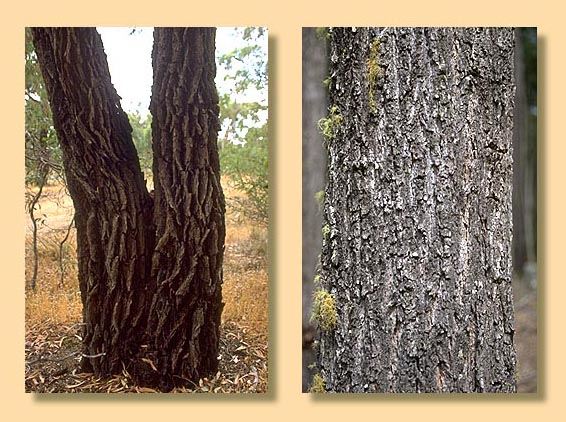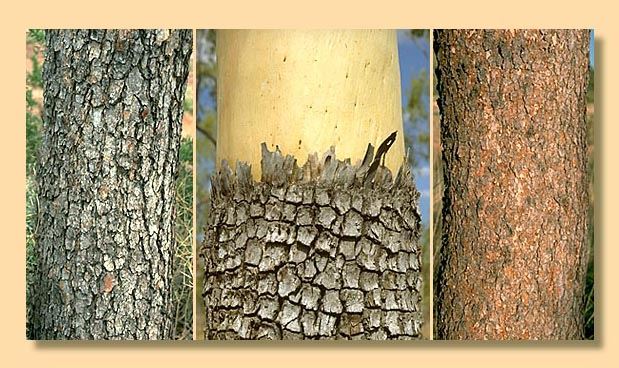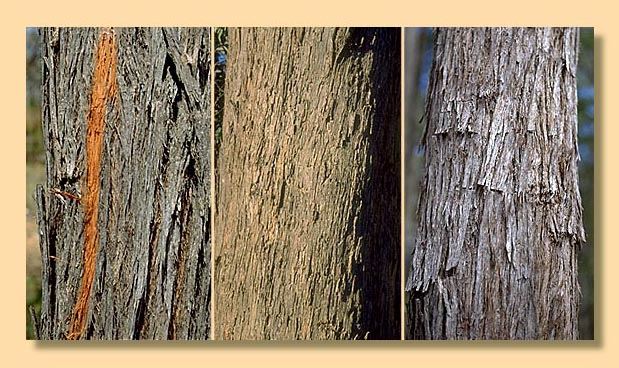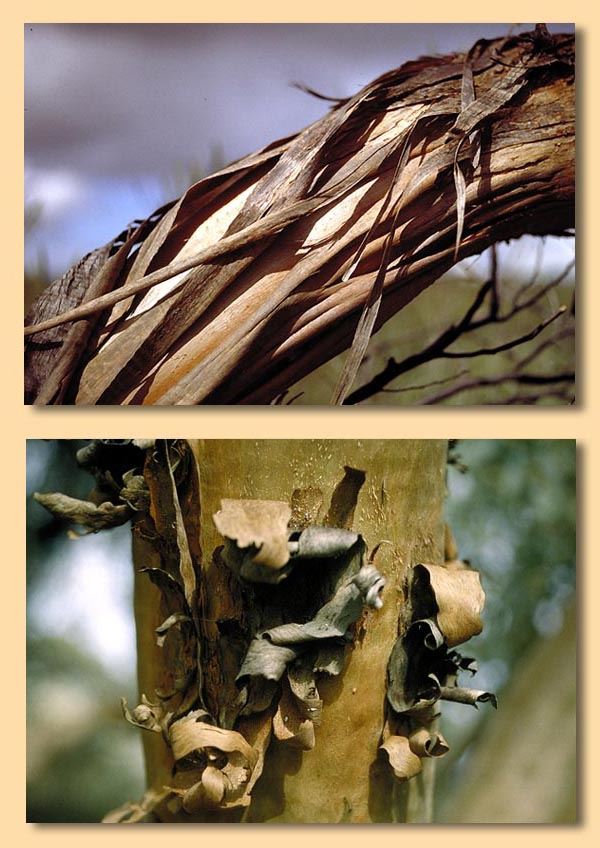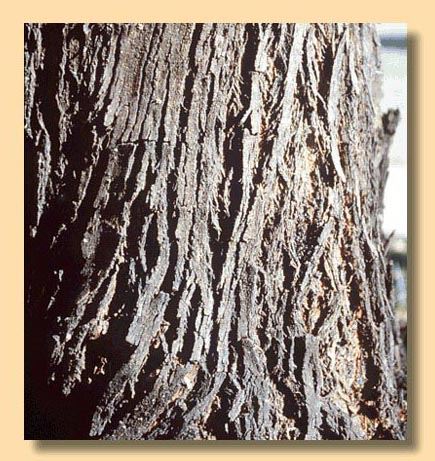Rough bark is the most difficult bark to assess. In such species the outer dead bark accumulates year by year and takes on recognizable forms that characterize taxonomic groups. Note that mature rough bark characteristics take a long time to develop and the older trees in a population should be assessed.
Ironbark
Hard, compacted, furrowed; covers whole trunk. The term ironbark is in common usage in eastern Australia, less so in other parts of the country. In ironbark species the rough bark usually is suffused with an exudate (kino) which hardens. The bark becomes longitudinally furrowed with age and varies in colour from grey to black or red-black, e.g. Euvcalyptus sideroxylon, E. crebra. Some ironbark species, however, have all the appearance of the hard, furrowed ironbark character, yet the bark can be soft and somewhat flaky and friable e.g. E. placita and some forms of E. fibrosa. Therefore, the ironbark character may refer more to appearance and expectation rather than to fact! A few species in other eucalypt subgroups (e.g. E. sieberi, E. aromaphloia, E. indurata) have rough bark that is thick, hard and furrowed as in the traditional ironbarks.
Tessellated
The outer dead bark breaks up into discrete small flakes (tesserae or small tiles) and covers part or all of trunk, loosely or firmly held. Found mainly in red bloodwoods (e.g. Corymbia gummifera, C. terminalis), yellow bloodwoods (e.g. C. watsoniana) and some ghost gums (e.g. C. tessellaris). Some box species (e.g. Eucalyptus ochrophloia), and a few other species in a variety of eucalypt subgroups (e.g. E. dundasii, E. gomphocephala) show tessellated bark on older trunks, although in these cases not all of the rough bark on a trunk will necessarily be tessellated. The most distinctly tessellated bark is seen in C. tessellaris, whilst the most colourful tessellated bark is found in the desert dwelling red bloodwoods where the outer grey flakes are irregularly shed to create a mottled pattern with the newly revealed bark being orange-brown, fading to brown and grey.
Stringy or fibrous
Recognized by the conspicuous long or short fibres that are more or less longitudinal on the trunk or criss-crossed to some degree, closely arranged or loosely woven; the bark has a thick, more or less furrowed appearance or is quite thin; covers part or all of the trunk. Stringy or fibrous bark can be easily abraded or pulled by hand to show the length of the fibres - short and closely packed to long and stringy. Colour is usually grey on the outside, rarely brown, with the underbark often shades of orange, red, brown or yellowish grey. Stringy or fibrous bark does not become suffused with resinous exudate as happens in ironbark or compacted bark. Species with stringy or fibrous bark include the stringybarks (e.g. E. globoidea) and peppermints (e.g. E. radiata) of eastern Australia and Jarrah (e.g. E. marginata) of Western Australia, and many other species in a variety of eucalypt subgroups (e.g. E. cinerea, E. delegatensis, E. acmenoides, E. robusta). Stringy or fibrous is the most common type of rough bark.
Box
Short-fibred bark that often flakes or crumbles; covers part or all of the trunk. Often grey (e.g. E. microcarpa), sometimes mottled grey and white (e.g. E. albens, E. moluccana) or even brown-yellow (e.g. E. melliodora). Sometimes tightly held, sometimes also tessellated in patches on older trunks (see above), or in many species, loose and flaky. Thickness is variable and shedding is irregular, or in many species does not occur at all. Not impregnated with exudate. The box eucalypts form a large group of closely related species, but box-type bark also occurs in other distantly related species (e.g. E. bridgesiana, E. viminalis subsp. cygnetensis, E. loxophleba subsp. loxophleba). Application of the term "box bark" to some Eucalyptus species probably derives from similarity with the bark of the commonly cultivated northern hemisphere species Buxus sempervirens which, when grown as a tree, develops a rough grey shaggy bark on the trunk.
Imperfectly shed ribbons, strips or curls
Loose and rough due to the imperfect shedding of dead bark; on part or all of stems and possibly the larger limbs, never very thick. The general appearance is quite variable depending on whether a given species normally sheds in long coarse ribbons, shorter thin strips or in irregular flakes. For example E. hypochlamydea often has a rough trunk clothed in coarse, partly detached ribbons which hide the living bark. E. astringens has a trunk that is often almost smooth but seasonally may have numerous small rough curling flakes of dead bark adherent to the surface giving a scruffy appearance. “Imperfectly shed ribbons, strips or curls” should not be confused with “loose basal slabs” which implies a thicker accumulation of dead bark only on the lower stem or trunk.
Compacted
Fibrous bark that is suffused with exudate and sets hard; over part or all of trunks. With age not becoming furrowed like ironbark, but may have small fissures. The bark colour is invariably very dark brown to black. In some species it forms only a short stocking (e.g. Eucalyptus elata), or may cover entire trunk (e.g. E. kondininensis) or even extend to the branches (e.g. E. crenulata). A few species (e.g. E. elata) are rough for the basal 1-3 m only. They may be known as blackbutts. In E. sieberi this type of bark may cover the whole trunk and in older individuals become furrowed like ironbark (see above) Other species, like E. crenulata, may have compacted blackish bark extending to the branches.
Loose basal slabs
Thick accumulation of dead bark only on the lower stem or trunk, rarely for more than a metre, bark otherwise smooth. All smooth-barked species shed their dead bark at some time. Many species, particularly in cultivation, hold some of their dead bark loosely over the lower trunk for quite some time before being shed. Particularly old individuals may also exhibit this character. e.g. Eucalyptus oreades, E. regnans.
Clearly, this is an ambiguous bark type which takes experience to assess. Not to be confused with “imperfectly shed ribbons, strips or curls”.
If no decision can be made, this and another bark form will have to be selected, or the rough bark character should be bypassed altogether.
